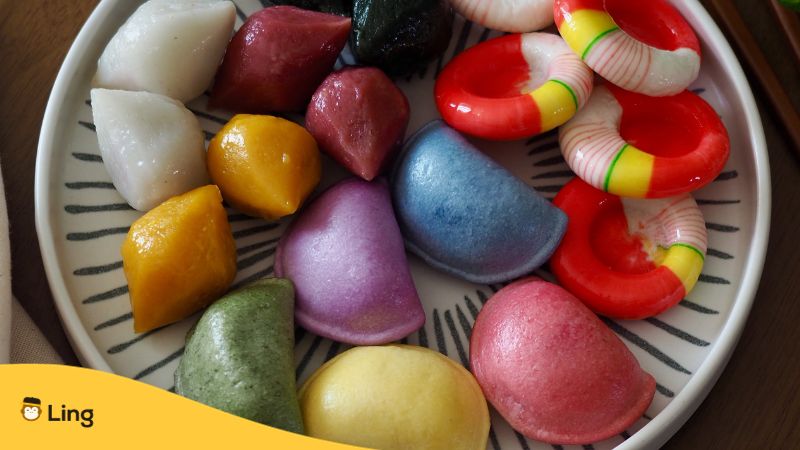Have a sweet tooth? Embarking on the candy-laden journey through Korea starts with one word: “사탕” (satang). But wait! There are still a lot of Korean words for candies that you need to know, including the crowd favorites like “젤리” (jelly), “캬라멜” (caramel), and “초콜릿” (chocolate). Curious and want to learn more? Read on below!
The Cultural Significance Of Candies in Korea
Candy in Korean or “사탕” (satang) symbolizes joy, celebration, and togetherness. Just as you’d offer chocolate, lollipop, and other sweets on Valentine’s Day in the West, in Korea, gifting candies is a tradition on special occasions like weddings and holidays.
Korean candies come in different flavors, shapes, and colors. Some are iconic, while others are regional specialties waiting to be discovered. You can savor classics like “솜사탕” (somsatang), which are fluffy cotton candies, or explore the chewy delight of “엿” (yeot), a traditional Korean taffy. Don’t forget to try the popular “젤리” (jelli), Korean jelly candies, and the unique “빼빼로” (Pepero) sticks, Korea’s answer to Pocky.

Why Learn Korean Words For Candies?
While many see candies simply as sweet treats, they often hold deeper stories, echoing traditions, tales, and time-honored customs. This sentiment stands true for places like South Korea, where age-old sweets tell tales alongside their contemporary counterparts. But why zoom in on the Korean lexicon for confectionery? Let’s unwrap that sweet mystery.
- Mastering candy names and terms enhances your shopping or gastronomic adventures in Korean locales, promising a genuine culinary escapade.
- Adding candy nomenclatures to your Korean word bank is not just delightful; it’s memorable. It sets the stage for lively interactions with locals, turning everyday chats into flavorful discussions.
- Perfectly pronouncing treats, even the intricate ‘Seolleongtang’, can spark admiration and warmth from Korean pals or peers.
- Who said studying a language can’t be sugary? Introducing candy themes can pour fun into your Korean linguistic expedition, transforming it from a task to a treat.
5 Popular Korean Candies
Korea, with its rich history and rapid modernization, offers a delightful blend of traditional and contemporary when it comes to sweets. Here’s a closer look at some of the standout candies that have found their place in the Korean confectionery landscape:
Dalgona (달고나)
Imagine a candy with a toffee-like consistency, a perfect blend of melted sugar, and a hint of baking soda, pressed into a flat shape, its surface adorned with intricate designs. This, my friend, is Dalgona. Although many across the globe first encountered Dalgona during the sensational rise of the “Squid Game” series on Netflix, for many Koreans, this treat is an evocative journey down memory lane, capturing the essence of bygone days.
Choco Pie (초코 파이)
Envision biting into a soft, fluffy treat, feeling the marshmallow filling melt in your mouth, all encased in a delicate chocolate exterior. This modern delight is none other than Choco Pie. Available at every nook and corner in Korean convenience stores, its popularity isn’t just taste-based. The Choco Pie has inadvertently become a beacon of South Korean goodwill, especially towards North Korean defectors, solidifying its iconic status.
Pepero (빼빼로)
Picture a slender biscuit stick, generously coated with chocolate, occasionally dressed up with nuts or vibrant sprinkles. This delightful snack is known as Pepero. Its allure doesn’t just stop at its taste. Come November 11, Koreans celebrate Pepero Day, a unique cultural phenomenon where these sticks become tokens of affection, gifted between friends, family, and lovers. This tradition amplifies Pepero’s charm, making it more than just a treat – it’s a gesture of love.
Jelly (젤리)
The moment you think of “jelly,” your mind might wander to those squishy, translucent sweets that wobble at the slightest touch. In Korea, they embrace this treat with the term “젤리.” But don’t be fooled – Korean jellies aren’t just the typical fruity variety. Their range extends to diverse flavors, even including local delicacies.
During my exploration of Korean streets, I was charmed to find that jellies, or 젤리, were not just kid favorites. From young ones eagerly reaching for a packet at the store to adults indulging in sophisticated jelly desserts at cafes, it’s clear – 젤리 is a treat that resonates with every generation, bridging the taste gap with its versatile charm.
Satang (사탕)
Often when we hear “hard candy,” it evokes images of shiny, colorful sweets with a crystalline texture. In Korea, this delightful treat goes by the name of Satang. Satang isn’t limited to a single note. Its flavor palette dances between fruits to refreshing mints, promising a burst of taste with every bite.
During my stay in Korea, I also realized that Satang is a staple for all ages. Whether you’re a child savoring its sweetness or an adult reminiscing about days gone by, this candy captures the essence of nostalgia and pure, unadulterated joy.
Korean Words For Candies
When one embarks on a taste journey through Korean candies, they encounter a flavor tapestry that tells tales of ancient traditions intertwined with contemporary delights. From roots with remedial tales to beans that paint a canvas of sweet memories, here’s an exploration of Korea’s candy flavor voyage:
Ginseng (인삼 – Insam)
Venture into the heart of Korea with Ginseng, a root deeply ingrained in the nation’s culture. Noted for its medicinal prowess, Ginseng’s distinct bitter and earthy notes dance harmoniously with sweet undertones. It’s no ordinary candy flavor – Ginseng-infused hard candies or lozenges often serve a dual purpose, delighting the taste buds while offering healthful benefits.
Red Bean (팥 – Pat)
Red bean sweeps you into a world of tradition. Transformed into a sweet paste, this flavor finds its essence in countless Korean sweets. From being the heart of rice cakes to lending its taste to chewy confections, red bean is a nostalgic flavor, evoking memories of ancestral celebrations.
Green Tea (녹차 – Nokcha)
The serene experience of sipping green tea is encapsulated in candies that strike a beautiful balance between its subtle bitterness and accompanying sweetness. Be it in chewy delights, hard candies, or the modern spin of green tea-infused Choco Pies, Nokcha remains a flavor that calms the senses.
Tangerine (귤 – Gyul)
Let the sweet citrusy notes of Jeju Island tangerines transport you to sunlit orchards. Renowned and adored, this tangerine essence breathes life into hard candies and gummies, offering a burst of refreshment and sunshine with each bite.
Honey (꿀 – Kkul)
Honey, nature’s liquid gold, is a cherished sweetener in Korean confections. Whether it’s the traditional Yakgwa honey cookies that narrate tales of old or the contemporary chewy candies and lollipops, honey’s mellifluous taste binds generations together.
Sesame (참깨 – Chamkkae)
Embark on a nutty escapade with sesame. Whether it’s the rich allure of black sesame or the gentle whisper of its white counterpart, its taste is a treasured one in Korea. Found in toffees, brittles, and often in a sweet duet with honey, sesame is a flavor that resonates with warmth and tradition.

Expressions Related To Buying, Sharing, And Enjoying Candies
Planning to visit Korea? Here are some useful expressions to use!
| English | Korean Script | Korean Pronunciation |
| Please give me candies. | 사탕 사주세요 | Satang saju-seyo |
| How much is this candy? | 이 사탕 얼마에요? | I satang eolma-eyo? |
| Let’s eat candies together! | 같이 사탕 먹자! | Gati satang meokja! |
| Let’s share the candies. | 사탕을 나눠 먹어요 | Satangeul naneo meok-eoyo |
Sweeten Your Tongue With More Korean Candy Words With Ling
Now, it’s time to add a dash of linguistic sweetness to your Korean learning experience. Ling, available on both the Play Store and App Store, is your gateway to making language learning easier and as delightful as savoring your favorite Korean candy. With Ling’s interactive activities and games, you can turn learning Korean into an engaging adventure as fun as indulging in a sugary delight. So, why wait? Download Ling today and let the flavors of Korean candies inspire you to improve your skills.



































































